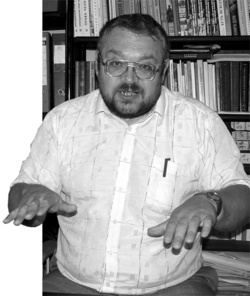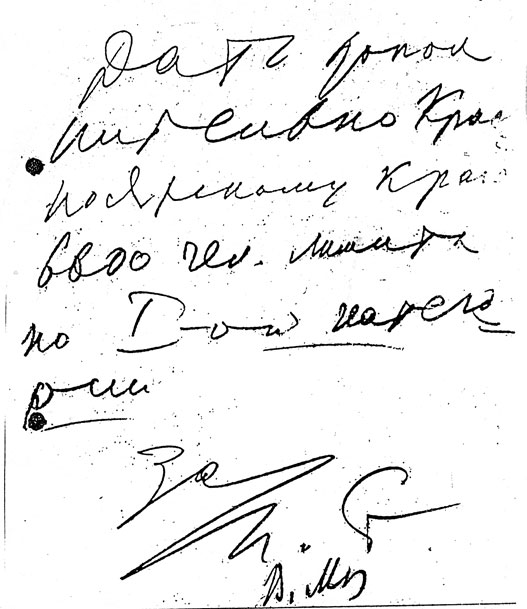









 Seventy years ago there was working an infernal machinery, which modern
historians gave the name of “The Great Terror” and which is called “the year 37”
among the people. On the 30 July 1937 the NKVD issued its Order N° 00447. which
was the beginning of the “Kulak Operation”. In the Krasnoyarsk Territory 18000
people were repressed for political reasons within just one year, 12000 of them
were executed.
Seventy years ago there was working an infernal machinery, which modern
historians gave the name of “The Great Terror” and which is called “the year 37”
among the people. On the 30 July 1937 the NKVD issued its Order N° 00447. which
was the beginning of the “Kulak Operation”. In the Krasnoyarsk Territory 18000
people were repressed for political reasons within just one year, 12000 of them
were executed.
The GIGANTIC dimension of the “bloody purge” applied to the entire region and comprised all sections of the population – from high-ranking government officials up to farmers and workers, who were far from being interested or involved in politics.
The CHAIRMAN of the Krasnoyarsk “Memorial” Organization - Aleksei Babiy – says that the permanent repressions carried out in the USSR, i.e. the period of “Great Terror” are engraved on the mind of of the people as “the time of horror”. Until today many believe that this horror happened only in 1937.
- In actual fact, 20000 individuals were shot in the Krasnoyarsk Territory during the Soviet regime. In all, about 60000 inhabitants of the region were affected by repression for political reasons.
But while they would send two out of three persons into camps before 1937, the proportion was just the other way round during the “Great Terror”, when two were executed, while one was sentenced to detention in a camp. The government issued directives exactly defining concrete numbers. In the very first month the authorities of the Krasnoyarsk Territory were instructed to shoot 750 people. The Krasnoyarsk chekists fulfilled the “plan” very quickly and then did not hesitate to send Stalin a telegram asking for new “limits”, and he was voluntarily prepared to give his “OK”. Afterwards the limits were raised several times yet.
- The STATE POWER, in fact, gave its “OK” for the mass murder of people…
- The action was carried out on the initiative of the Polit Bureau of the Central Committee of the All-Russian Communist Party (Bolsheviks). In July the issued the first directive, on the 5 August they started with the extermination of people. The very first who came under the fire, werer those who had aristicratic roots, officers of the White Army or expropriated farmers who had been deported to Siberia. They wer eall on the books of the NKVD. According to the opinion of the “Supreme Power” they were the ones who had reason enough to be discontented with the Soviet governmenet.
At that time the whole country was terror-stricken. The people used to sit on their packed-up suitcases at night-time, timidly listening to the noises from the street, to automobiles stopping I front of the house, racking their brains about whether or not they would come for them today or – pass by. The files of inquiry of the year 1937 which are kept in the archives look very poor. As a rule, we will find nothing but two interrogation protocols: the first gives evidence about the arrestee denying his guilt on all charges, on the second – we will find for sure the signature of the accused by which he “approved” the fabricated confession. In July of this horrible year, exactly at the same time when the NKVD order was issied, an encoded telegram was sent into all directions: it gave the official permission to apply torture during future questionings. However, the examing magistrates had already broken loose from all restraint before, anyway. Being in receipt of the official permission, however, the now began to rage like wild beasts - with a vengeance.
- And the system of denouncing was working excellently, as well.
- This was the worst. Many people tried to solve their own problems by simply denouncing somebody else. If you intended to “trip your boss up” – you just libelled him with the NKVD. And the NKVD had to fulfill the norm … For that reason they did not even take the slightest trouble to find out about the backgrounds of such false statement once a letter of this kind had been played into their hands.
There were cases, when a wife wanted to get rid of her husband; she wrote just one sentence to express that at night-time he always used to write something into his diary. Or two fellows loved one and the same girl, who finally gave preference to the first. The other one denounced her, thus solving the problem of shared love. The most disgusting thing about all this was that the system allowed the people to sink that low, for it more and more waked their ambition to behave mean. Those, however, who tried their best to leas an honest life, were the great losers of this cruel fight- the ended up in camps.
By the way, there is yet another depravity, another characteristic with the system of that time – mutual responsibility. Just o0en any newspaper of the year 1937 you like and you can be sure that you will find remarks about meetings of work collectives, during which workers angrily condemn hostile intrigues and call for the execution of the “guilty” person.
- What kind of sensational actions were carried out in the region?
- The whole story began with the mill combine in kansk. After extensive repair work it started to work again on the 25 August. Soonafter, a fire broke out. Two people died, three were injured, the damage ran into several million rubels. At first it was said that this “extraordinary incident” happened due to a technical defect … But the Chekists in Kansk were obviously frightened. The sent Stalin a telegram with the following wording: It is reported that numerous exiles work for the combine – so that we have every reason to believe that the incident was a hostile play of intrigue. Stalin replied that, without any doubt, it was a hostile subversive activity – the culprits have to be found and executed.
Shortly after, the entire managerial staff in the Kuragino District was dismissed and executed by a firing squad. The whole economical system in itself was a chaotic one: everything was decided “upstairs” – when the sowing was to be done and when the farmers were to bring in the harvest. And in case the chop yield turned out to be less than expected, it was not the fault of the Soviet power, no – it had been done on intent by a ring of saboteurs. In general, all occurrences of this kind were interpreted this way. When a locomotive jumped off its rails, the NKVD classified it as an intrigue committed by the Trotzkyists. Between 1937 and 1939 the Yeniseysk inland navigation suffered from an increasing number of collisions. Why did this happen? Astanenko, a famous Chekist at that time, had “swept off” all captains, pilots and mechanics. And those who took their place did not dispose of the necessary skill and experience to do the job. They were soon labelled spies and saboteurs, as well.
However, against the background of all the vociferous revealments in the country, our matter seemed to be a bagatelle for the local NKVD. And so they came up with something else yet, as, for example, the affair around the first director of the “Stolby” National Park – Aleksander Yavorskiy. They accused him of having formed up a group of young stolbyists, who were to enter the Kremlin in order to commit a terroristic act against Comrade Stalin. As a result the director received his “tenner” (he was sentenced to a ten years’ detention in a camp; translator’s note).
- WHAT do you think - why do people nowadays sink into nostalgy when they hear Stalin’s name, wish for a “strong hand” and the erection of memorials to the honour of the generalissimo?
- The descendants of the executed do not idealize Stalin. Even though there are many who are of the opinion that Stalin had not the slightest idea of what was going on in his country. However, documents prove the exact opposite: he gave the orders himself, signed the lists of those to be shot in person, hoping that they would never become public. Later, the leader was, as we would call it today, a master of “Public Relations”, who knew how to keep away from all negative developments. He extirpated the executors and himself appeared in the spotlight as an outstanding personality.
Until today the myth has survived that Stalin merely extinguished the very top of the ruling party. But this myth can be easily swept off – just have a look at the long lists showing the victims of repressions. Flip open any Book of Memory you like – you will find the names of stablehands, carpenters, caretakers, face-workers, etc.
-Your own family suffered from repressions, as well. Does it have any influence on your attitude towards today’s chekists – the representatives of the KGB?
-There have been fair and straight staff members with both NKVD and KGB, but
most of them sooner or later found themselves in a camp, too, and in many cases
were even shot.
I work closely on the Book of Memory with numerous FSB employees, and I can
express nothing but words of gratitude. However, I am very concerned about the
tendency which has become apparent lately. The FSB stopped to feel ashamed of
what happened during the time of the “Great Terror”. They commence to justify
the operations and actions of the NKVD personnel by saying that they just
executed orders. And we do not only find this phenomenon among the ordinary
staffers, but even among high-ranking officials. Since 2005 it has been
practically impossible to work with archival files. And the names of the former
examining magistrates are simply removed from the Books of Memory. Those, who
intend to keep the names of the executors secret, give reason to assume that
they themselves would be prepared to do such things. This might create a
situation, in which an order is issued and – everything will recur. A very
worrying and alarming fact.
BY THE WAY

This directive was signed by Stalin personally in 1937; by this document he expressly granted the chekists of Krasnoyarsk the permit to additionally execute 6.600 individuals. * 1st category – execution, 2nd category – detention in a camp or prison.
Olga LOBZINA
Photo by the author
“Arguments and Facts on the Yenisey”, 01.08.2007